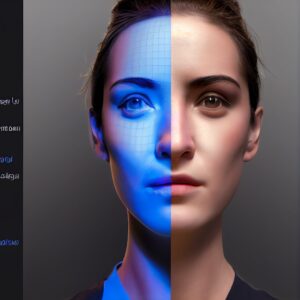Facial recognition technology has emerged as a key asset in modern security and research projects. Using advanced algorithms, this system identifies and verifies individuals by analyzing and comparing unique facial features. In the security sector, facial recognition enables the rapid detection of suspects, enhances access control, and strengthens surveillance operations in critical environments. Through its application in real-time monitoring systems, retrospective video analysis, and biometric authentication, facial recognition is reshaping how institutions protect assets, people, and information — always with growing attention to regulatory compliance and ethical standards.
What is facial recognition?
Facial recognition is a technology that uses cameras and artificial intelligence algorithms to analyse the unique characteristics of a person’s face. The technology can identify and verify a person’s identity by analysing features such as the shape of the face, size and position of the eyes, nose, mouth and ears.
Facial biometry can be performed in two ways: live and still images. In live, the system captures an image of the person’s face in real time and compares it with a database to identify the person. In still images, the image of a person is compared with a database of previously recorded images.
What is face recognition used for in the areas of Security and Investigation?
This technology has been used in a variety of applications in security and investigation. In security, facial recognition has been implemented in airports, government buildings, schools and mass events to detect suspicious persons and prevent criminal acts. The technology is also used in surveillance systems, such as security cameras, to identify criminals or wanted persons and assist in cases.
In research, facial recognition is used to analyse people’s behavior and predict criminal behavior. The technology has been implemented in psychological studies to analyse facial expressions and determine people’s emotions. It is also used to identify victims and suspects in cases of sex crimes and human trafficking.
Benefits of facial recognition in security and investigation
Facial recognition offers several benefits for Security and Investigation. In the first case, this technology can help prevent criminal acts and protect people. The technology can also help identify missing persons and suspects of serious crimes.
In investigation, facial recognition can help agents identify both victims and suspects, and determine the relationship between them. It can also be useful in analyzing people’s behavior and emotions and help in predicting future crimes.

How facial recognition works
This technology works through a series of stages:
First, a facial image is captured, either through a camera or from a video recording.
Next, facial recognition software uses algorithms to analyse the facial characteristics of the person in the image. These algorithms look for specific features, such as the distance between the eyes, the length of the nose and the shape of the jaw.
Once these features have been identified, the software compares this information with a database of previously analysed images. If a match is found, the software can provide a positive identification of the person in the photo.
Although facial recognition can be very accurate, there are certain factors that can affect its effectiveness. For example, the quality of the image can influence the accuracy of facial recognition, as can the angle from which the image was taken or the ambient lighting.
Applications of face recognition in security and research
Facial biometry has proven to be a valuable tool in a wide range of security and research applications. Here are some examples of how it is currently being deployed:
1.Public safety: In many cities, facial recognition has been used to help identify and apprehend dangerous criminals. For example, this software can be used to analyse security camera images in real time and alert authorities when a match with a wanted criminal is detected.
2. Victim identification: Facial recognition has also been used to identify victims in disaster situations. For example, after the 9/11 attacks in New York, rescue teams used facial recognition to identify victims in the rubble.
3. Criminal investigation: Facial recognition can help authorities identify suspects in crime cases. For example, it can be used to analyse images from security cameras in the vicinity of a crime scene and provide possible suspect identifications.
4. Border control: Facial recognition systems are increasingly being used at border controls to improve security. For example, it can be used to compare a person’s passport image, with their live image to verify their identity.
5. Access to buildings and systems: Facial recognition is also being used to improve security in restricted buildings and systems. For example, it can be used to allow access to a building only to authorised persons, which improves security and reduces the risk of intrusion.
Facial recognition is a technology widely used in the areas of security and research, thanks to its ability to identify people or verify their identity. Although there are still some concerns about its use in terms of privacy and accuracy, it is a valuable tool in the fight against crime and the protection of the public, if used effectively and in compliance with the law and it can be integrated in Intelion along with other AI analytics.
